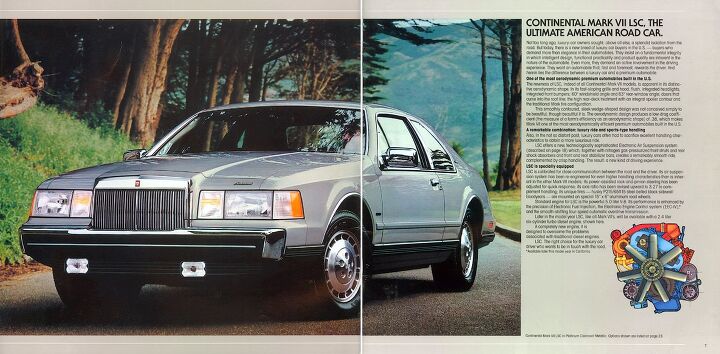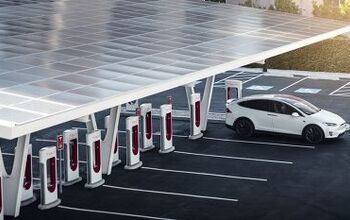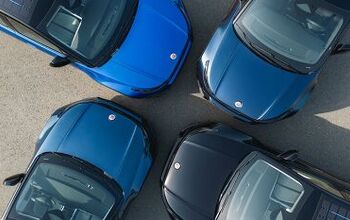Rare Rides Icons: The Lincoln Mark Series Cars, Feeling Continental (Part XXXVIII)

After a review of the Lincoln Continental Mark VII’s completely revamped and modernized styling in our last entry, we’ll spend this today on its interior. As Lincoln attempted to draw a new, more youthful well-heeled customer base to the Mark, the PLC traditionalist of yore faded away. And said youthful customer - usually with an eye on European cars - was less interested in acres of faux wood panel, ruched velour, traditional instruments, and overstuffed button-tufted interiors.
As might be expected, the decrease in all exterior dimensions in the transition from Mark VI to VII was accompanied by a decrease in interior room as well. Most notable was the width: The interior folks at Lincoln had much less to work with on the Mark VII than its predecessors. There was only a slight decrease in the Mark’s width when it moved onto the Panther platform for 1980, as its 78.1 inches was close enough to the 79.7” of the Mark V. But the Fox was no full-size platform, and the modern new Mark VII spanned only 70.9 inches.
Note: Information below pertains largely to trims other than the sporty LSC, which was devoid of wood decor.
A driver who entered the new Mark VII in 1984 found only remnant details of Marks gone by. Faced with a more modern two-spoke steering wheel, the four-spoke Panther design was binned. The wheel was sleeker and had a better implementation of wood trim on its lower half, a notable difference from the Mark VI’s wood-clad center wheel pad, and thin wood strip on the wheel rim. Worth noting, the Mark VI was the only Mark to use a four-spoke wheel.
The Mark VII’s dash was still a vertical affair but was less of a cliff face than the Mark VI's. With a sharply defined center console, there was a notable separation between driver and passenger in Mark VII. Lincoln’s interior design aimed for the “driver’s car” look with its new iteration, and followed the same driver and passenger separation theme that worked for the Thunderbird for many decades.
There was a distinct absence of wood trim in front of the passenger, a first for any Mark generation. A tradition that remained was the small Mark VII badge, inlaid in gold into the dash. Other decorations for passenger viewing enjoyment included two rectangular vents.
Digital gauges retained their basic three-binnacle design from before, with a fuel level indicator, speedometer, and odometer from left to right. Analog gauges were fitted on the sporty LSC model, but not until later in the run in 1986. The gauge binnacles themselves were smaller than before, more recessed, and looked a bit less formal.
Flanking the digital pods were vents, and a central warning light system that was smaller than on the Mark VI, and looked better integrated. New to Mark’s dash design was a second row of buttons and switches that contained things like lighting functions, the antenna control, and the electronic trip computer. Though such a computer was present in Mark VI, it had more functions in the VII and looked more at home.
We take an aside to a flight of Mark VII fancy now, as Lincoln also developed an advanced CRT-based control system for the coupe called COMTECH. According to the Ford press release, the CRT displayed driver information and allowed climate control adjustment. The car also had more advanced radio and graphic equalizer functions. Two new control pods attached to the wheel contained a total of 10 switches and allowed for fingertip control of common functions. Revised and more detailed gauges in the experimental car were LCD. Though COMTECH was announced in November of 1984, the system never saw production.
In the production car, the area below the trip computer was occupied by the high-tech stereo with the requisite Eighties equalizer and the climate control system. The automatic transmission shifter was on the floor (a first) and leather-wrapped. The Mark traditionalist surely reached for a column shifter that was not there on more than one occasion. Another first was found just south of the shift gate, as the window and mirror switches migrated to the center console.
Door panel design moved on from the conservative traditional look displayed in prior versions of the Mark: Wood trim shrank from the great slabs of the Mark VI to much more restrained usage. The wood decorated a door panel that featured the seat controls, and its forward edge mimicked the shape of the interior door pull. Said pull was now an integrated handle instead of a luggage strap style. The interior door handle was simplified as well, and made of metal. It had a distinct lack of chrome, wood trim, or lamps around it, and looked similar to an old straight razor.
Seats with an actual shape were a new thing for the Mark VII, as bolsters appeared, cushions became more shapely, and excessive strapping, buttoning, padding, ruching, and bedazzling went by the wayside. Buckets up front made the Mark VII a dedicated five-passenger vehicle for the first time. Likely the Fox platform’s aforementioned cozy interior dimensions were a factor in the permanent switch to bucket seats instead of a bench but said seat style was well on its way out by the Eighties.
Rear seat passengers sat closer together than any previous Mark, and the middle seat was suitable only for children. Rear seat sculpting mimicked the bucket seats at the front and had similar stitching according to trim. All seats looked more serious and sporty regardless of the trim level selected, though LSC customers received much additional bolstering at the front. Given the standard center console, Lincoln’s engineers provided a new feature for rear seat Mark passengers: Vents!
Lincoln’s marketing material was keen to point out how the Mark VII had moved beyond the traditional, obviously a big change of pace for a model which courted only the traditionalists in past iterations. The copy implied that tradition was no longer enough, and luxury required more.
Though the Mark VII looked forward in a big way, its profitable Designer Series trims returned for their last outing. Though they were consolidated further than before, the headline of trim of the day was actually the sporty variant called LSC. We’ll pick up there next time.
[Images: Ford]
Become a TTAC insider. Get the latest news, features, TTAC takes, and everything else that gets to the truth about cars first by subscribing to our newsletter.

Interested in lots of cars and their various historical contexts. Started writing articles for TTAC in late 2016, when my first posts were QOTDs. From there I started a few new series like Rare Rides, Buy/Drive/Burn, Abandoned History, and most recently Rare Rides Icons. Operating from a home base in Cincinnati, Ohio, a relative auto journalist dead zone. Many of my articles are prompted by something I'll see on social media that sparks my interest and causes me to research. Finding articles and information from the early days of the internet and beyond that covers the little details lost to time: trim packages, color and wheel choices, interior fabrics. Beyond those, I'm fascinated by automotive industry experiments, both failures and successes. Lately I've taken an interest in AI, and generating "what if" type images for car models long dead. Reincarnating a modern Toyota Paseo, Lincoln Mark IX, or Isuzu Trooper through a text prompt is fun. Fun to post them on Twitter too, and watch people overreact. To that end, the social media I use most is Twitter, @CoreyLewis86. I also contribute pieces for Forbes Wheels and Forbes Home.
More by Corey Lewis
Latest Car Reviews
Read moreLatest Product Reviews
Read moreRecent Comments
- Bd2 Lexus is just a higher trim package Toyota. ^^
- Tassos ONLY consider CIvics or Corollas, in their segment. NO DAMNED Hyundais, Kias, Nissans or esp Mitsus. Not even a Pretend-BMW Mazda. They may look cute but they SUCK.I always recommend Corollas to friends of mine who are not auto enthusiasts, even tho I never owed one, and owned a Civic Hatch 5 speed 1992 for 25 years. MANY follow my advice and are VERY happy. ALmost all are women.friends who believe they are auto enthusiasts would not listen to me anyway, and would never buy a Toyota. They are damned fools, on both counts.
- Tassos since Oct 2016 I drive a 2007 E320 Bluetec and since April 2017 also a 2008 E320 Bluetec.Now I am in my summer palace deep in the Eurozone until end October and drive the 2008.Changing the considerable oils (10 quarts synthetic) twice cost me 80 and 70 euros. Same changes in the US on the 2007 cost me $219 at the dealers and $120 at Firestone.Changing the air filter cost 30 Euros, with labor, and there are two such filters (engine and cabin), and changing the fuel filter only 50 euros, while in the US they asked for... $400. You can safely bet I declined and told them what to do with their gold-plated filter. And when I changed it in Europe, I looked at the old one and it was clean as a whistle.A set of Continentals tires, installed etc, 300 EurosI can't remember anything else for the 2008. For the 2007, a brand new set of manual rec'd tires at Discount Tire with free rotations for life used up the $500 allowance the dealer gave me when I bought it (tires only had 5000 miles left on them then)So, as you can see, I spent less than even if I owned a Lexus instead, and probably less than all these poor devils here that brag about their alleged low cost Datsun-Mitsus and Hyundai-Kias.And that's THETRUTHABOUTCARS. My Cars,
- NJRide These are the Q1 Luxury division salesAudi 44,226Acura 30,373BMW 84,475Genesis 14,777Mercedes 66,000Lexus 78,471Infiniti 13,904Volvo 30,000*Tesla (maybe not luxury but relevant): 125,000?Lincoln 24,894Cadillac 35,451So Cadillac is now stuck as a second-tier player with names like Volvo. Even German 3rd wheel Audi is outselling them. Where to gain sales?Surprisingly a decline of Tesla could boost Cadillac EVs. Tesla sort of is now in the old Buick-Mercury upper middle of the market. If lets say the market stays the same, but another 15-20% leave Tesla I could see some going for a Caddy EV or hybrid, but is the division ready to meet them?In terms of the mainstream luxury brands, Lexus is probably a better benchmark than BMW. Lexus is basically doing a modern interpretation of what Cadillac/upscale Olds/Buick used to completely dominate. But Lexus' only downfall is the lack of emotion, something Cadillac at least used to be good at. The Escalade still has far more styling and brand ID than most of Lexus. So match Lexus' quality but out-do them on comfort and styling. Yes a lot of Lexus buyers may be Toyota or import loyal but there are a lot who are former GM buyers who would "come home" for a better product.In fact, that by and large is the Big 3's problem. In the 80s and 90s they would try to win back "import intenders" and this at least slowed the market share erosion. I feel like around 2000 they gave this up and resorted to a ton of gimmicks before the bankruptcies. So they have dropped from 66% to 37% of the market in a quarter century. Sure they have scaled down their presence and for the last 14 years preserved profit. But in the largest, most prosperous market in the world they are not leading. I mean who would think the Koreans could take almost 10% of the market? But they did because they built and structured products people wanted. (I also think the excess reliance on overseas assembly by the Big 3 hurts them vs more import brands building in US). But the domestics should really be at 60% of their home market and the fact that they are not speaks volumes. Cadillac should not be losing 2-1 to Lexus and BMW.
- Tassos Not my favorite Eldorados. Too much cowbell (fins), the gauges look poor for such an expensive car, the interior has too many shiny bits but does not scream "flagship luxury", and the white on red leather or whatever is rather loud for this car, while it might work in a Corvette. But do not despair, a couple more years and the exterior designs (at least) will sober up, the cowbells will be more discreet and the long, low and wide 60s designs are not far away. If only the interiors would be fit for the price point, and especially a few acres of real wood that also looked real.







































Comments
Join the conversation
This car harkens back to a bygone era.
I liked everything about the new Mark VII, especially the sound of the duel exhaust, so I bought a black with black leather LSC in 1990. I was with IBM's US Marketing Division. It was my daily driver. That meant a steady 1,000 miles a month. In the opinion of my family, clients, and my friends the LSC first me like a glove. With it's tinted windows and always detailed to within an inch of it's life, I guess I would have to agree. Oh and the black Ray Ban sunglasses, I would have to agree, I was the buyer who Lincoln was gunning for. It was beautiful, classy, kinda sporty, and it sounded fantastic. I loved that car.